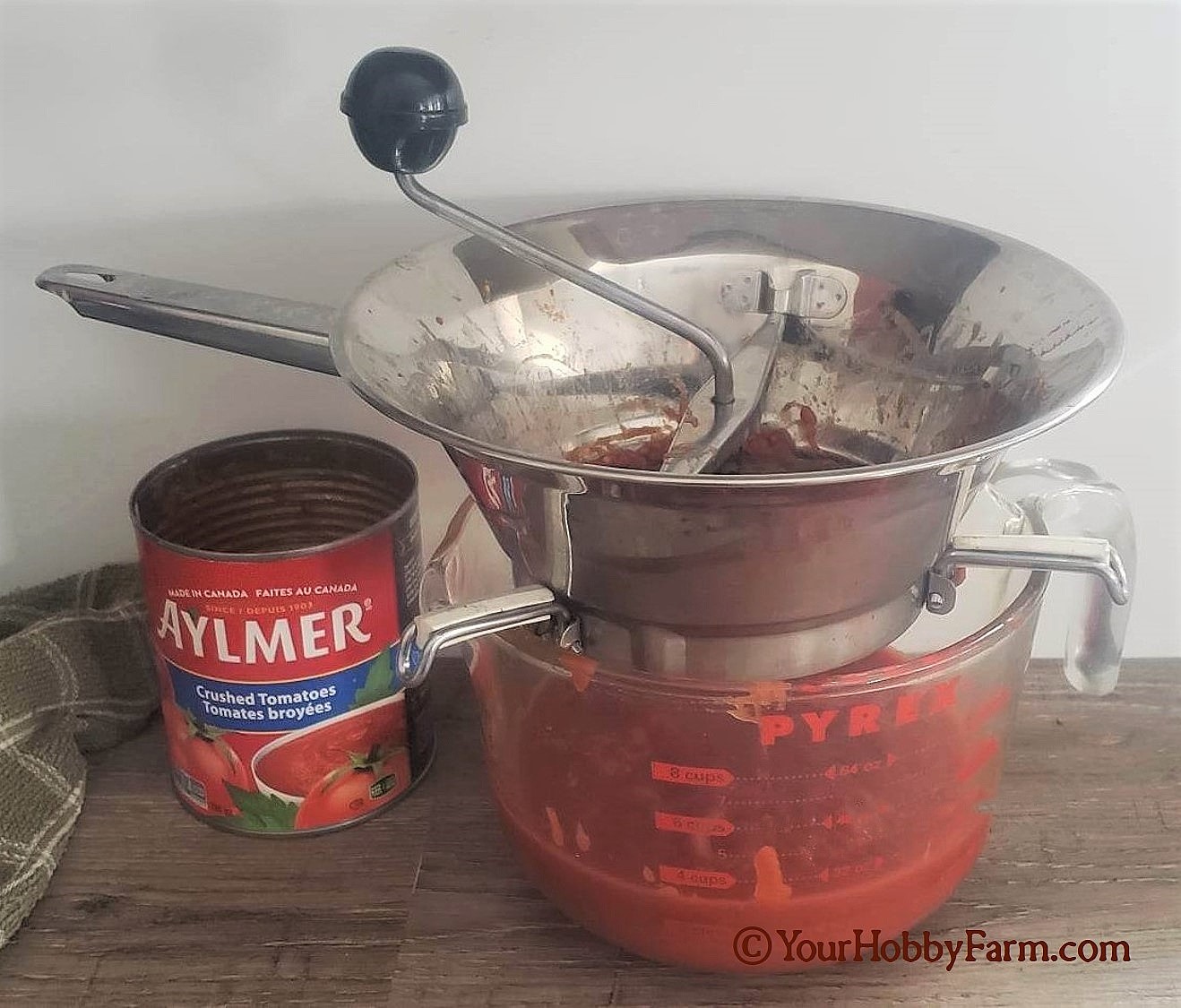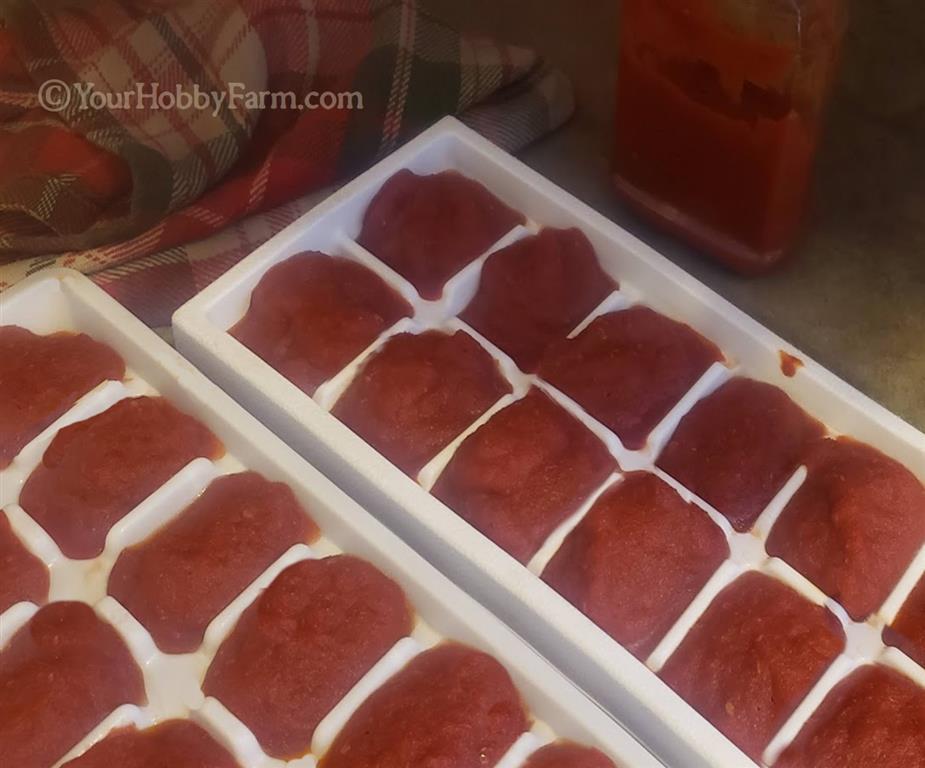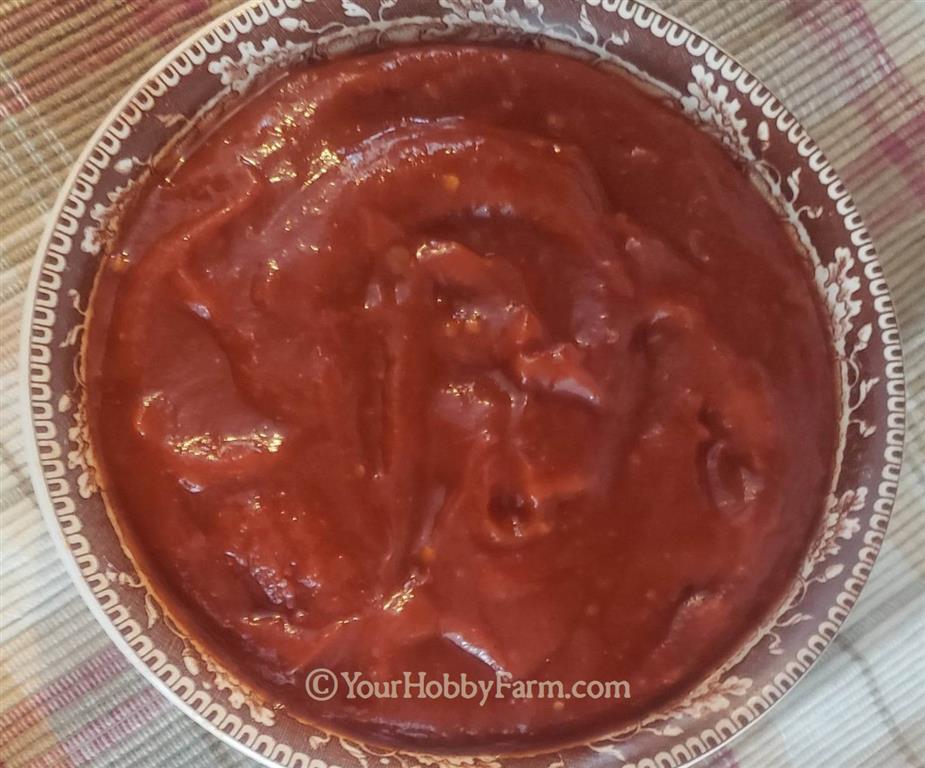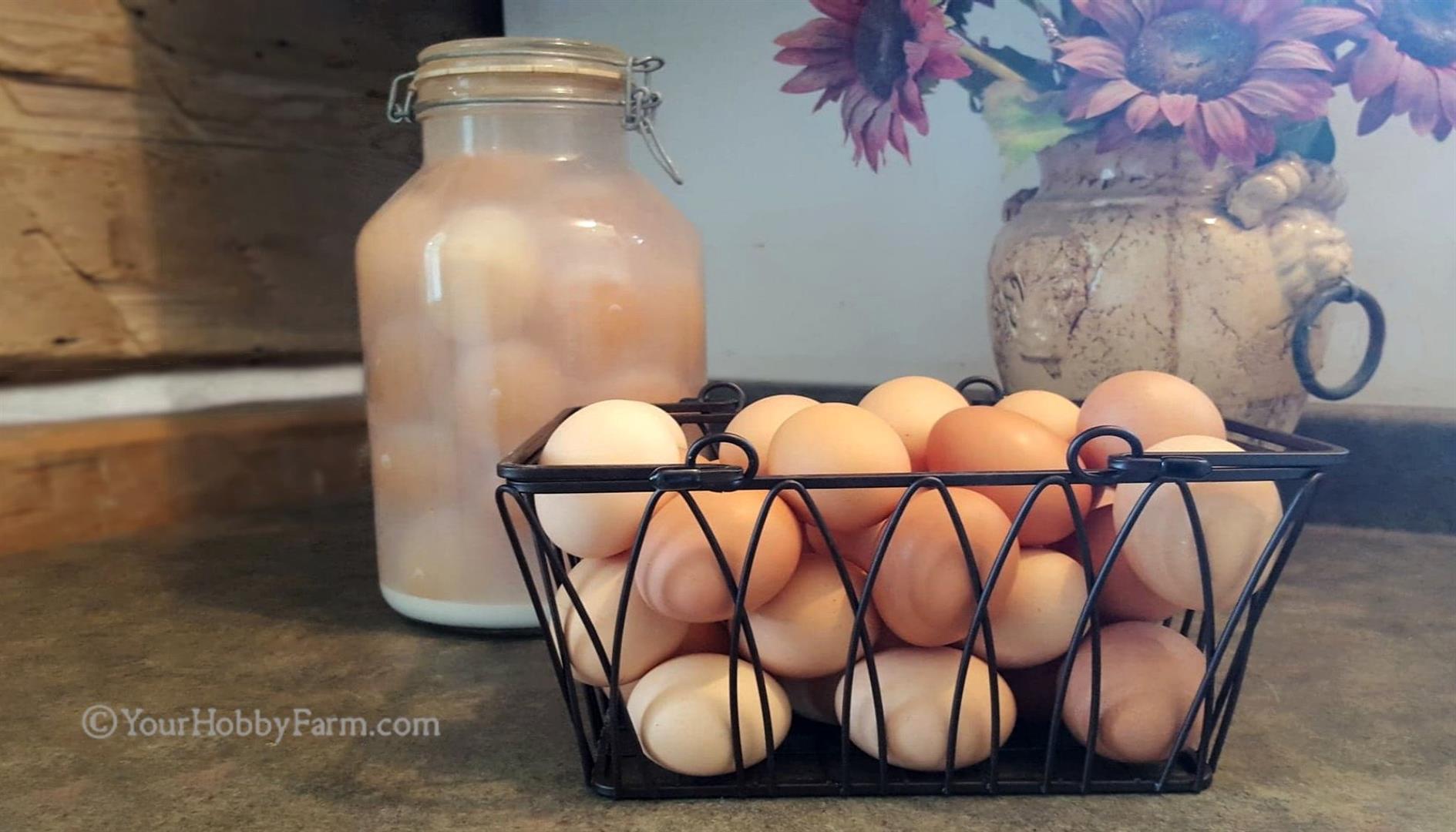Easy, Healthy Homemade Ketchup Recipe
That's Seriously Yummy!
Hey friends and followers! We're changing our website address from YourHobbyFarm.com to HomesteadJoys.com.
With ongoing homestead responsibilities, this transition may take some time. Save our New Logo and QR code for easy navigation! We’d love you to join us in our journey!
 Homestead Joys Logo
Homestead Joys LogoWondering about how to make homemade ketchup? This homemade ketchup recipe is not only simple and easy, it's also seriously yummy! And it's been 'kid approved'! Made with natural ingredients, it's healthy, delicious, and so simple to make. While this recipe calls for canned tomatoes, making ketchup with fresh tomatoes, if available, is great too! We've said good-bye to trips to the grocery store for commercial ketchup brands with their unhealthy additives. Give it a try, we think you'll love it as well!
Barb Says: "My husband, Dave, loves this homemade Ketchup recipe 😋
Delicious! Thank you, I will add this recipe to my collection."
Why Make Homemade Ketchup?
Because You Know What's in It!
Knowing exactly what's in your ketchup, or any other food, actually really does matter! Since eating is simply feeding our bodies, what are we feeding them? Our health, how we feel, in many ways depends on what we eat.
 It's very important to read the labels on commercial foods so we know what we're putting into our bodies.
It's very important to read the labels on commercial foods so we know what we're putting into our bodies.By reading labels, we can learn a lot! Nowadays we see those two ambiguous words, “natural flavors”, everywhere! Sounds healthy? Well, guess again. If they actually listed what is being hidden behind those two words, many times we wouldn't even consider eating it!
How much better to choose pure, truly natural, organic, non-GMO, chemical-free, foods. By finding simple and delicious recipes to replace commercial brands which we may tend to depend on, we can avoid things like highly processed ingredients, high fructose corn syrup and artificial sweeteners, preservatives, flavor enhancers like MSG and worse, dangerous chemicals, etc. For example, our greatest exposure to aluminum comes from our dietary intake. Who needs to be eating aluminum?
Making our own delicious food, choosing to use ingredients that are pure and healthy, is extremely beneficial to ourselves, our families, and anyone else that we may cook for! Our homemade ketchup recipe contains no preservatives, no corn syrup, artificial sweeteners, artificial colors, no taste-enhancers, nor any other hidden, so called, "natural ingredients".
This Easy Homemade Ketchup Recipe is Seriously Yummy!
Some have asked how to make homemade ketchup. We're delighted to show you and we believe that you'll be very pleased with the outcome!
Anabelle (age 5) says: "Mmmm, I love this ketchup, Mama! This ketchup is SO good!" (Shared by Anabelle's Mama)
What makes this the BEST homemade ketchup recipe? Besides tasting truly delicious, this homemade ketchup recipe is also so easy to make, and you know exactly what's in it! Additionally, it's more frugal to make your own ketchup than running off to the grocery store to buy more when you run low. Here's how we do it:
Our Easy, Yummy, Homemade Ketchup Recipe

Ingredients:
- 1 796 ml/28 oz *can of Crushed Tomatoes
(or about 4 cups fresh, diced, cooked, drained tomatoes) - 1 156 ml / 6 oz can of Tomato Paste
(or a 369 ml / 12oz can if you prefer thicker ketchup) - 1/3 cup of **Pure Maple Syrup (or a healthy alternative)
- 1/3 cup Vinegar
(we mix Red Wine Vinegar and White Wine Vinegar. You can use ACV or any vinegars, alone or mixed) - 1 1/4 teaspoon Salt (we like Redmond Real Salt, but you can use any sea salt or unionized salt)
- 1/2 teaspoon Onion Powder (homemade onion powder is delicious!)
- 1/4 teaspoon Garlic Powder
- 1/4 teaspoon Celery Salt
- 1/4 teaspoon Allspice
Directions:
1. Important: if you'd rather not have tomato seeds in your homemade ketchup, run the can of crushed tomatoes (or about 3 1/2 cups of your diced, cooked and drained tomatoes) through a stainless steel manual food mill as seen in the photo, or through a strainer.
2. Place tomatoes in a saucepan or crock pot. Add the rest of the ingredients to the tomatoes and mix well.
3. Simmer on very low heat, uncovered, for 1 to 3 hours to thicken and add richness to its taste, melding the flavors together.
Stir frequently, making sure that this does not scorch or
burn.
4. When your ketchup is at your desired consistency and flavor, remove the ketchup from the heat and allow to cool.
5. When thoroughly cooled, place your homemade ketchup into a jar or serving container. Reusing ketchup bottles or other condiment containers works well.
You can also freeze any extra ketchup it in an ice cube tray or a non-glass container.
And remember, allowing your newly made ketchup to sit in the fridge overnight allows the flavors to continue to mature and meld together nicely, improving the taste even more!
Enjoy!!
Recipe Notes:
Using either canned or fresh, diced, cooked tomatoes, this makes about 3 cups of Homemade Ketchup. You can easily multiply the ingredient amounts if you'd like to make larger batches.
This recipe is a winner among our family and friends. We suggest that you try it as written here for the first time. Then, if you feel like changes would make it perfect for your palate, below are some suggested adjustments.
- If you prefer it a bit sweeter, next time you can add a bit more maple syrup, raw sugar, or healthy alternative.
- For a bit less, or more, zip and zing, you can slightly alter the amount of Celery Salt and Allspice. You can alter the amount onion and garlic powders and salt a bit as well.
- And, if you enjoy a kick of piquant, how about adding a bit of black pepper, paprika, chili powder, or a pinch of cumin?
Be creative and enjoy flavorful adventures!
Also, tomatoes differ in levels of acidity. If your ketchup is a bit too acidic for your taste, try putting the tiniest "pinch" of baking soda to reduce the acidity. It's better to start with a just a wee half a pinch or less, then, if it's not quite enough, add a tiny bit more if needed. It's so easy to use too much! Even just a bit too much will flatten and ruin the taste of your ketchup, so be very careful not to over-do on the baking soda!
* If your tomatoes, canned, or fresh cooked, are watery, drain off access juice. Also, you can add more tomato paste if you'd like, to make it a bit thicker. While making ketchup with fresh tomatoes is ideal, if you don't have any available, make this ketchup with canned crushed tomatoes. We would recommend using organic, or at least, GMO-free if possible. Many don't have ready access to fresh tomatoes; therefore, we've used canned in this recipe.
** Maple Syrup is a healthy, natural sweetener which adds a rich, sweet flavor. However, if you don't have access to any, here are some suggestions for some healthy alternative for maple syrup, which include some recipes to make them yourself. Or, you might choose a common substitute for pure maple syrup from this list. Keep in mind that a mild flavored replacement would be better for this homemade ketchup recipe than one with a stronger, distinctive flavored sweetener.

Making Ketchup with Fresh Tomatoes
There is a very real sense of satisfaction knowing that you're completely in control of every ingredient that you choose to use in your homemade ketchup as well as being able to fine-tune the taste!
However, using your own homegrown tomatoes, fresh from the garden is a luxury that not everyone is able to enjoy. If you have a garden or have access to a farmer's market, we'd encourage you to try making ketchup with fresh tomatoes!
You can use different varieties for making ketchup with fresh tomatoes, depending on what you have available. If given a choice, it's helpful to avoid super juicy varieties. Plum tomatoes, like Romas, work well as they tend to have a firmer, meatier texture, less water, and fewer seeds. This reduces some work and cook time for you. But whether your tomatoes are large or small, meaty or juicy, they can be used for making our homemade ketchup recipe.
When making ketchup with fresh tomatoes, simply wash the tomatoes, remove the stems, and dice them up. Simmer them for about 30 minutes, or until the tomatoes are soft. Strain off the juice and pass your tomatoes through a food mill or sieve to remove the skin and seeds. If you'd like to make it thicker, simmer a bit longer. When the consistency is good, you're ready to follow the recipe above using 3 1/2 cups of fresh cooked tomatoes instead of canned.
The recipe makes about a quart of ketchup. If you have a lot of tomatoes to process, you can double, triple, or quadruple the recipe above to make as much as you'd like. But measure out your cooked tomatoes by 3 1/2 cups so that you know how much to multiply the other ingredients by.
As you'll see below, there are several ways to preserve ketchup when you make larger batches.
Andrea (Mother of 4) says: "Thank you for this recipe, it's delicious! It will replace the store bought brands for our family."
How Long Does Homemade Ketchup Last?
We'd recommend that this homemade ketchup be refrigerated. Some say that it lasts for 3 to 4 weeks, while others who make homemade ketchup say that it will keep for up to a year, but is best within 6 to10 months.
However, if you think of it, ketchup might also be considered a pickled condiment. Pickles are basically vegetables in a mixture of vinegar, sugar, salt, water, and seasonings. Ketchup is also a vegetable/fruit slurry, with vinegar, sweetener, salt, and seasonings added to it. So theoretically, the vinegar and maple syrup help preserve the ketchup.
It gets used up pretty quickly around here, but if it takes longer in your home, we'd also suggest preserving your homemade ketchup. Try one or more of these ways of preserving your homemade ketchup, especially when you're making larger batches.
Ways to Preserve Homemade Ketchup
Our homemade ketchup gets eaten fast! But if you make extra, here are some ways to preserve your homemade ketchup.
Freeze it! Can you freeze ketchup? Yes! Ketchup freezes and thaws wonderfully! We go into detail below...
Can it! How to can homemade ketchup? Instead of freezing it, sometimes we water bath can Ketchup using the hot pack method. Leave 1/4” headspace and process the 1/2-pint jars for 15 minutes. If you're unfamiliar with water bath canning, watch this water bath canning video before attempting this method.
Dehydrate it! We haven't tried this method yet, but some preserve their ketchup by dehydrating it! You can make ketchup leather, which would great for backpacking. Other uses come to mind as well. You can also dehydrate it further then grind it into ketchup powder! Imagine the many ways that you might use this too! Apparently, this can be reconstituted back into ketchup by adding some water to the ketchup powder.
Ferment it! You might even want to try this recipe for making Probiotic Homemade Ketchup.
Michael Says: "Just wanted to say that my wife made this homemade ketchup recipe for our family to try. We really enjoyed it! I'd give it a 10/10! I'm pretty sure that we won't be buying ketchup from the grocery store anymore! Thanks!"
Here's How We Freeze Homemade Ketchup
Our preference for preserving homemade ketchup is to simply freeze it. Not only does it freeze well, but the consistency after it's thawed is the same as before, with the fresh, delicious flavor nicely preserved.
We recommend using silicon or plastic ice cube trays to freeze ketchup. After the ketchup has completely cooled, fill the cavities of your ice cube tray.
Each 'vacancy' in our ice cube trays hold approximately 2 tablespoons, which is 1/8 of a cup. This is a handy way to measure the amount we'd like to thaw to use. 8 cubes of frozen ketchup equal 1 cup of thawed catchup. Freezing it in ice cube trays is also very handy when preserving smaller amounts.
Once the cubes are solidly frozen, they're easy to remove. Transfer them to a large plastic freezer bag or airtight container.
If you'd like, you can also freeze it in a plastic container that you'll be serving it in. We would not recommend freezing it in a glass container as they will often break with expansion that occurs during the freezing process.
Remove the amount needed. Thaw at room temperature. Give your ketchup a stir before serving.
Daniel Says: "Woah!! This ketchup is freaking good!!
It's way better than Heinz or the other store-bought brands! It's delicious!"
A Bit of History: Where Did Ketchup Come From?
We all know ketchup, or catsup, as the universal, tomato-based table condiment with a sweet and tangy flavor that we enjoy with a wide variety of foods. But the ketchup we've known and loved was not always what we enjoy today! In fact, it has undergone quite the metamorphosis over the years!
Surprisingly, early versions of ketchup weren't made with tomatoes at all!
It's said that in the 1600s, English sailors first discovered a "delightful sauce" in the Orient and brought this Chinese condiment with them back to the West. Ketchup, which comes from the Hokkien Chinese word, "kê-tsiap", was actually derived from fermented fish, and was similar to soy sauce. Around 1690, it was first mentioned in English print.
Over the ensuing years, ketchup continued to go through various stages of change, morphing in content, taste, and texture. It went from being fish based, to oysters, to mussels. Then it changed from having an egg white base, to a mushroom sauce, then nutty, to a savory, fruit based condiment, probably quite similar to what we'd call a chutney today.
The addition of tomatoes was introduced in the late 1700s, referred to as 'tomato soy'. And, in the late 1800s, the term 'ketchup' could also refer to a variety of different sauces with a thick consistency used as a condiment, very similar to this yummy looking Zesty Plum Ketchup recipe by 'Coconut & Lime'.
 Zesty Plum Ketchup recipe by Coconut & Lime
Zesty Plum Ketchup recipe by Coconut & LimeThen in 1812, an American scientist named James Mease is credited with creating a tomato-based ketchup. His formula was slightly altered over the years and in 1876 the Heinz company debuted the classic bottled ketchup as we know it today, still selling more than 650 million bottles a year around the world.
Today, we still enjoy ketchup, especially when we've made it ourselves! We choose healthy ingredients, and tweaking the taste to give our palates a party of exploding yumminess, we enjoy it with many different foods, in many different settings, knowing exactly what we're eating. This is why we offer you our Homemade Ketchup recipe.

And Some Have Asked: Is It Catsup or Ketchup?
So, what is catsup? Catsup vs. ketchup: is it catsup or ketchup? Or is there difference between ketchup and catsup?
 Is it catsup or ketchup? Is there a difference between ketchup and catsup?
Is it catsup or ketchup? Is there a difference between ketchup and catsup?Simpson Wiki
Catsup is the same tomato-based, sweet and tangy table condiment that we commonly call ketchup. According to a Heinz spokesperson, Henry Heinz first advertised his product as “Heinz Tomato Catsup". In the 1880s, Heinz Catsup was rebranded as "Ketchup" in order to stand out from their competitors. Later, in 1988, Del Monte, who had been calling their product "catsup", switched spellings as well after it became clear that "ketchup" was the popular choice.
"Ketchup" is the dominant term in America, Canada, England, and other countries as well. However, catsup is still commonly used in some southern US states and Mexico where the same condiment is referred to as “(salsa) cátsup”. In other areas around the world, "tomato sauce" is used as well.
So basically, when it comes to ketchup vs. catsup, they are two different names and spellings of the same flavorful, smooth tomato sauce. But it seems that it's mostly location that makes the difference between ketchup and catsup, more of the condiment, itself.
Whatever you call it, we're convinced that you'll be looking for foods on which to slather our tasty homemade ketchup! Enjoy!!
Healthy Homemade Ketchup
Have you tried making our Homemade Ketchup Recipe? If so, we'd love to know what you think. Or perhaps you have a different recipe for homemade ketchup that your family enjoys. Tell us about it! You can let us know in the form below, and please feel free to share your photos for your handiwork! It's fun to share and learn from one another.
Just click on the title box below and go from there. Be as wordy and descriptive as you like! Include quotes from your friends and family members about your homemade ketchup. There is plenty of room for your story and photos as well on our website. Then when published, you can share your story and pictures with your friends through 'your page' here on YourHobbyFarm.com!
What Other Visitors Have Shared
Click below to see contributions from other visitors to this page...
OhMyGoodness - The best ketchup EVER!!!! 




I heard wind that there was a reeeeeally good ketchup recipe on this website, so having run out of the standard store bought stuff, I followed the "Your …
Translate This Page!
Traduire Cette Page!
¡Traduzca Esta Pagina!



Piping Rock©
Bringing you the highest quality In hundreds of health care and life-enhancing natural products at the
lowest cost to you!
high reviews, crazy deals,
happy, healthy customers!
Click here and save today!
Business Appreciation
* This website is not affiliated with
Piping Rock

Supporting our local feed mills
Meunerie Alexandria Milling
613-525-1973
Great Products • Great Prices
Great Service
Click the pic for their
facebook page!
Meunerie Alexandria Milling
Established in 1962 by The Massie Family
Email: Alexandriamilling@hotmail.Ca
475 Massie Crescent
Alexandria, Ontario, Canada
~~~
Small Business Appreciation
* This website is not affiliated with
Meunerie Alexandria Milling






















